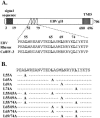The amino terminus of Epstein-Barr virus glycoprotein gH is important for fusion with epithelial and B cells
- PMID: 16160168
- PMCID: PMC1211543
- DOI: 10.1128/JVI.79.19.12408-12415.2005
The amino terminus of Epstein-Barr virus glycoprotein gH is important for fusion with epithelial and B cells
Abstract
Epstein-Barr virus (EBV) infects B lymphocytes and epithelial cells. While the glycoproteins required for entry into these two cell types differ, the gH/gL glycoprotein complex is essential for entry into both epithelial and B cells. Analysis of gH protein sequences from three gammaherpesviruses (EBV, marmoset, and rhesus) revealed a potential coiled-coil domain in the N terminus. Four leucines located in this region in EBV gH were replaced by alanines by site-directed mutagenesis and analyzed for cell-cell membrane fusion with B cells and epithelial cells. Reduction in fusion activity was observed for mutants containing L65A and/or L69A mutations, while substitutions in L55 and L74 enhanced the fusion activity of the mutant gH/gL complexes with both cell types. All of the mutants displayed levels of cell surface expression similar to those of wild-type gH and interacted with gL and gp42. The observation that a conservative mutation of leucine to alanine in the N terminus of EBV gH results in fusion-defective mutant gH/gL complexes is striking and points to an important role for this region in EBV-mediated membrane fusion with B lymphocytes and epithelial cells.
Figures




Similar articles
-
The Cytoplasmic Tail Domain of Epstein-Barr Virus gH Regulates Membrane Fusion Activity through Altering gH Binding to gp42 and Epithelial Cell Attachment.mBio. 2016 Nov 15;7(6):e01871-16. doi: 10.1128/mBio.01871-16. mBio. 2016. PMID: 27935841 Free PMC article.
-
Binding-site interactions between Epstein-Barr virus fusion proteins gp42 and gH/gL reveal a peptide that inhibits both epithelial and B-cell membrane fusion.J Virol. 2007 Sep;81(17):9216-29. doi: 10.1128/JVI.00575-07. Epub 2007 Jun 20. J Virol. 2007. PMID: 17581996 Free PMC article.
-
The KGD motif of Epstein-Barr virus gH/gL is bifunctional, orchestrating infection of B cells and epithelial cells.mBio. 2012 Jan 3;3(1):e00290-11. doi: 10.1128/mBio.00290-11. Print 2012. mBio. 2012. PMID: 22215569 Free PMC article.
-
[The entry of Epstein-Barr virus into B lymphocytes and epithelial cells during infection].Bing Du Xue Bao. 2014 Jul;30(4):476-82. Bing Du Xue Bao. 2014. PMID: 25272606 Review. Chinese.
-
Structural and Mechanistic Insights into the Tropism of Epstein-Barr Virus.Mol Cells. 2016 Apr 30;39(4):286-91. doi: 10.14348/molcells.2016.0066. Epub 2016 Apr 6. Mol Cells. 2016. PMID: 27094060 Free PMC article. Review.
Cited by
-
An Antibody Targeting the Fusion Machinery Neutralizes Dual-Tropic Infection and Defines a Site of Vulnerability on Epstein-Barr Virus.Immunity. 2018 Apr 17;48(4):799-811.e9. doi: 10.1016/j.immuni.2018.03.026. Immunity. 2018. PMID: 29669253 Free PMC article.
-
Structural basis for Epstein-Barr virus host cell tropism mediated by gp42 and gHgL entry glycoproteins.Nat Commun. 2016 Dec 8;7:13557. doi: 10.1038/ncomms13557. Nat Commun. 2016. PMID: 27929061 Free PMC article.
-
Epstein-Barr virus gp42 antibodies reveal sites of vulnerability for receptor binding and fusion to B cells.Immunity. 2024 Mar 12;57(3):559-573.e6. doi: 10.1016/j.immuni.2024.02.008. Immunity. 2024. PMID: 38479361 Free PMC article.
-
Herpes virus fusion and entry: a story with many characters.Viruses. 2012 May;4(5):800-32. doi: 10.3390/v4050800. Epub 2012 May 10. Viruses. 2012. PMID: 22754650 Free PMC article. Review.
-
A potent and protective human neutralizing antibody targeting a novel vulnerable site of Epstein-Barr virus.Nat Commun. 2021 Nov 16;12(1):6624. doi: 10.1038/s41467-021-26912-6. Nat Commun. 2021. PMID: 34785638 Free PMC article.
References
-
- Borza, C. M., and L. M. Hutt-Fletcher. 2002. Alternative replication in B cells and epithelial cells switches tropism of Epstein-Barr virus. Nat. Med. 8:595-599. - PubMed
-
- Browne, H. M., B. C. Bruun, and A. C. Minson. 1996. Characterization of herpes simplex virus type 1 recombinants with mutations in the cytoplasmic tail of glycoprotein H. J. Gen. Virol. 77:2569-2573. - PubMed
Publication types
MeSH terms
Substances
Grants and funding
LinkOut - more resources
Full Text Sources
Other Literature Sources

